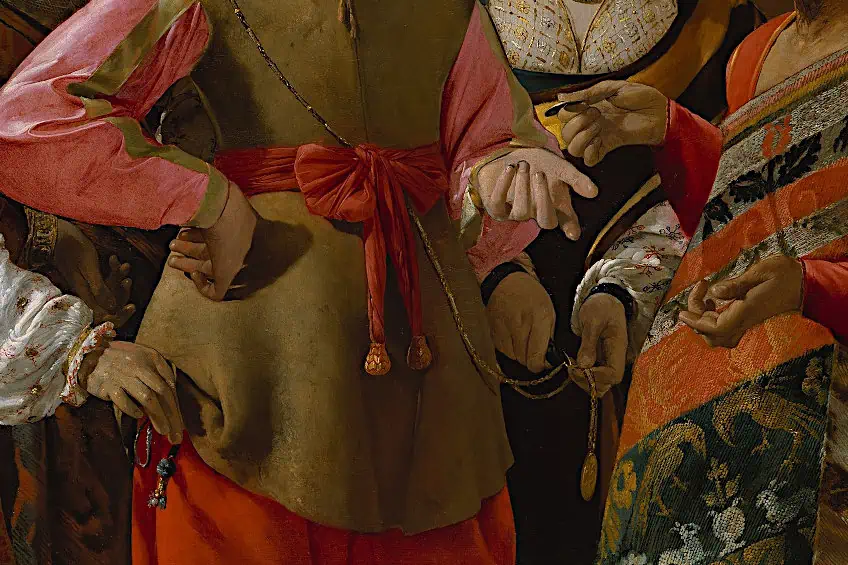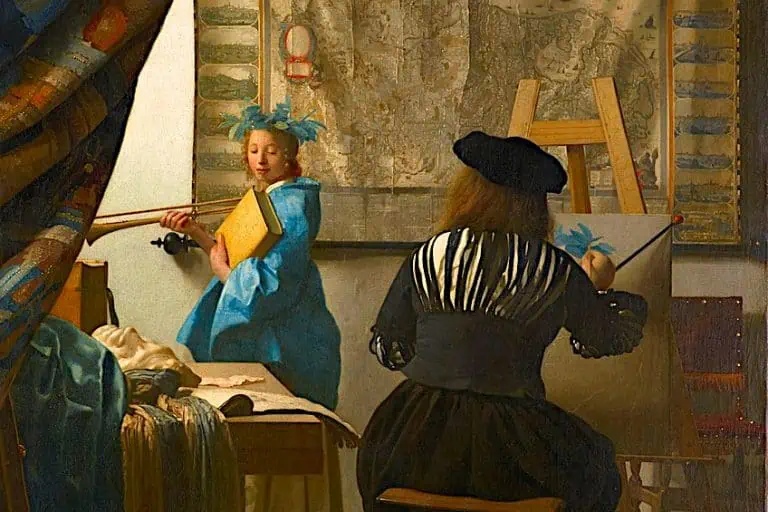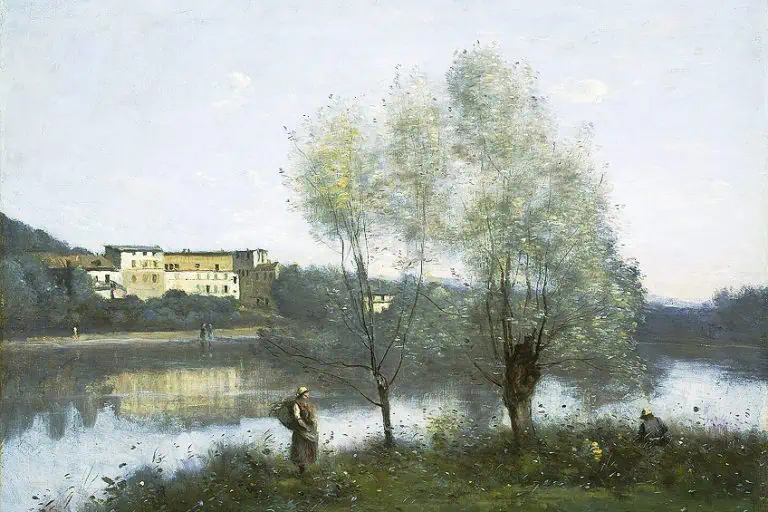Emphasis in Art – How Artists Hold and Guide a Viewer’s Attention
This post may contain affiliate links. We may earn a small commission from purchases made through them, at no additional cost to you.
What is emphasis in art and how do artists use it effectively in their works? Visual emphasis in art is one of the principles of art and is used to draw attention to a specific aspect of the piece, effectively giving it dominance over the other visual elements. By applying emphasis, artwork can lead the eye to the focal point, or around the canvas as desired by the artist. This article will examine examples of emphasis in art and the ways that artists use it.
Table of Contents
What Is Emphasis in Art?
In art, emphasis is intended to draw the audience’s eye to a certain section or subject. This is usually the artwork’s focal point or major theme. In portraiture, for example, the artist normally wants you to notice the person’s face first. They will utilize methods like contrast, color, and positioning to ensure that your attention is drawn to this area first. Each work of art can have more than one point of focus. Yet, one usually takes precedence over all others.
By placing emphasis on specific areas within a composition, an artist guides the viewer through the work. Encouraging a visual and conceptual exploration of the various elements that have been used to narrate an idea and/or evoke a set of emotions.
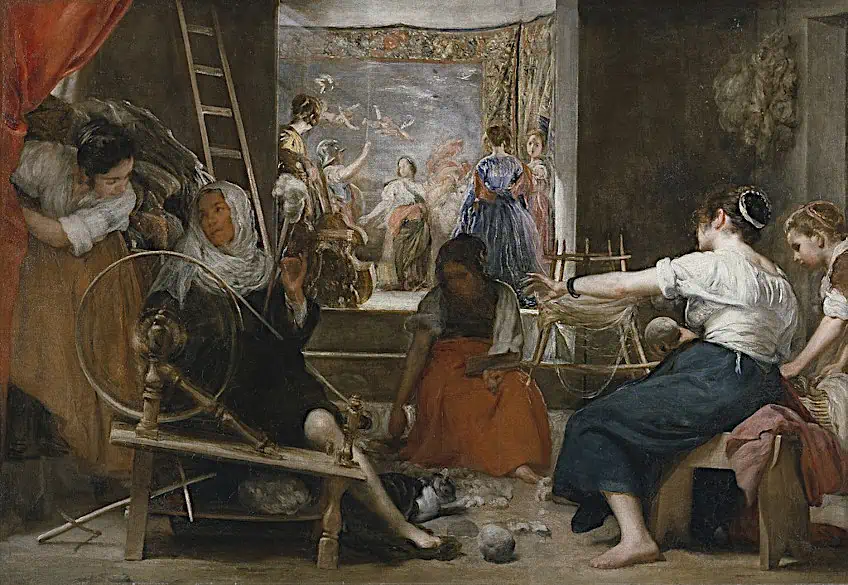 The Spinners or The Fable of Arachne by Diego Velázquez (c. 1656). In this intriguing image Velázquez uses multiple points of emphasis to combine two distinct, but related, scenes to tell the story of the spinner who competed against the goddess Athena; Diego Velázquez, Public domain, via Wikimedia Commons
The Spinners or The Fable of Arachne by Diego Velázquez (c. 1656). In this intriguing image Velázquez uses multiple points of emphasis to combine two distinct, but related, scenes to tell the story of the spinner who competed against the goddess Athena; Diego Velázquez, Public domain, via Wikimedia Commons
How Artists Use Emphasis in Art
Keep an eye out for emphasis while you study art. What methods did the artist utilize to produce this? What did they intend for you to notice first, and where does your eye travel after that?
Quite often the emphasis is nuanced, while other times it is not.
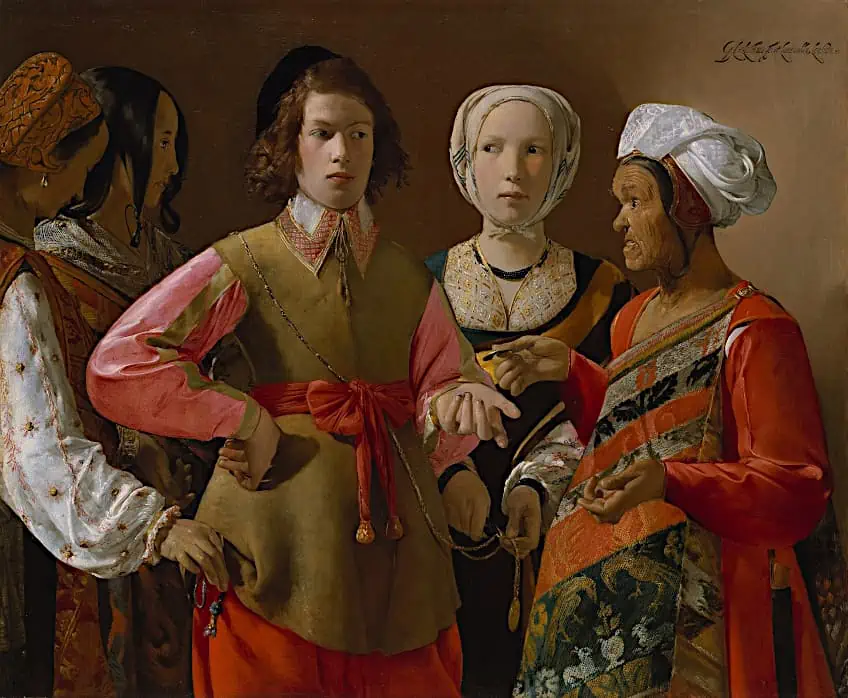 The Fortune Teller by Georges de La Tour (1630). In this image de La Tour uses various methods to create points of emphasis to reveal to the viewer how this gullible young man is robbed of his possessions by the fortune teller’s assistants; Georges de La Tour, Public domain, via Wikimedia Commons
The Fortune Teller by Georges de La Tour (1630). In this image de La Tour uses various methods to create points of emphasis to reveal to the viewer how this gullible young man is robbed of his possessions by the fortune teller’s assistants; Georges de La Tour, Public domain, via Wikimedia Commons
These are the subtle unexpected little surprises that artists leave for us to uncover, and it is uncovering them that makes art pieces so exciting. Emphasis is crucial in art because it helps an artist to direct the viewer’s exploration of the composition. A work of art without emphasis may appear dull or visually chaotic, with no obvious path for exploration. Let’s look at the various ways that artists use emphasis in art.
Contrast
One technique for creating a focal point in an artwork is to use contrast emphasis. Value, color, texture, and line are the most widely used elements. Most other features, on the other hand, can be deliberately arranged within a piece to produce a similar effect. Color is one of the most prevalent and easy-to-identify methods for creating emphasis via contrast. Using complementary hues in a painting, such as yellow and purple, for instance, immediately creates a sense of contrast. Complementary colors lie across from one another on the color wheel, making them the most contrasting.
Artists may also utilize isolated color, which occurs only once, or is used with greater intensity in one specific area within the composition. It will stand out, since it functions on a different visual register than the overall palette used in the artwork.
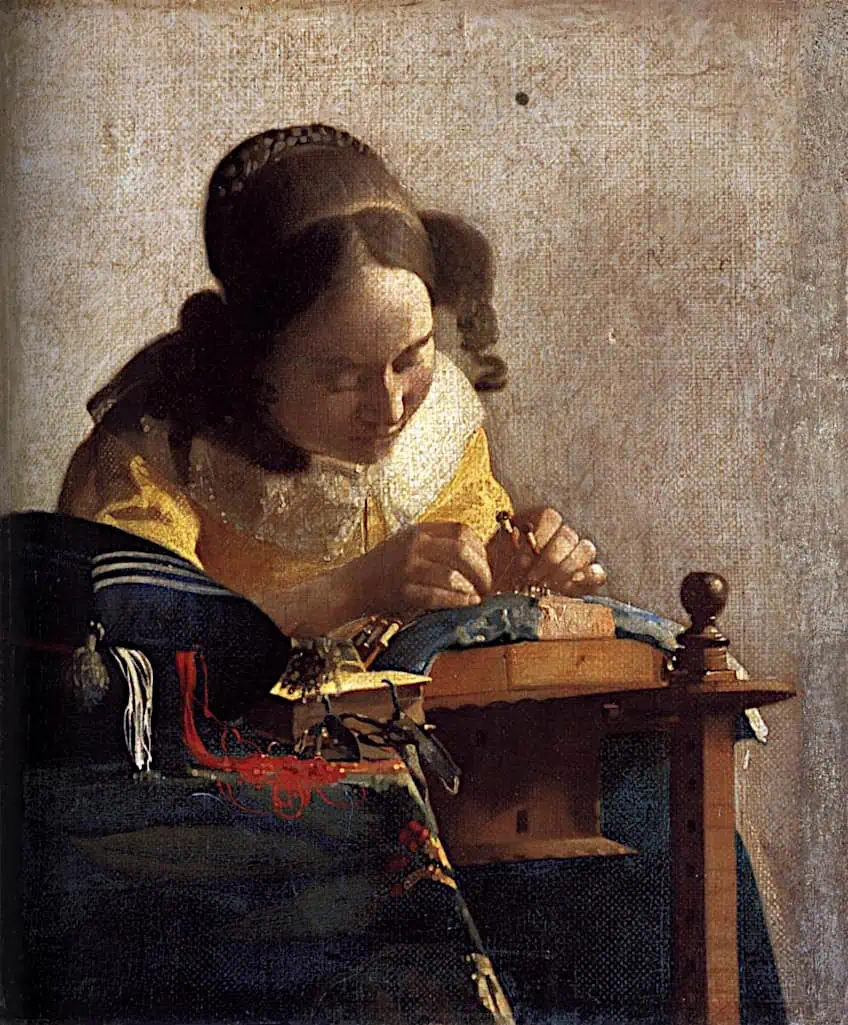 The Lacemaker by Johannes Vermeer (between 1669 and 1670). Note the visual impact of the red thread ion the foreground; Johannes Vermeer, Public domain, via Wikimedia Commons
The Lacemaker by Johannes Vermeer (between 1669 and 1670). Note the visual impact of the red thread ion the foreground; Johannes Vermeer, Public domain, via Wikimedia Commons
Another technique that artists might utilize is absent color, which is when one element in a picture is colored while the rest is monochrome, or vice-versa. Emphasis is created by using brighter values or muted tones in “strategically significant” areas. If appropriately placed, an area of a highly illuminated primary subject, or one in darkness, can instantly become the focal point.
Texture can be used to generate contrast if just the most significant object is textured, if it is not textured, or if it is textured differently than the remainder of the artwork.
Isolation/Separation
Isolation or separation is a method used in art to emphasize a certain element by visually isolating it from the rest of the piece. You may produce a feeling of isolation and accentuate the subject by enclosing an element within negative or empty space.
Negative space may also give the composition a feeling of harmony and equilibrium.
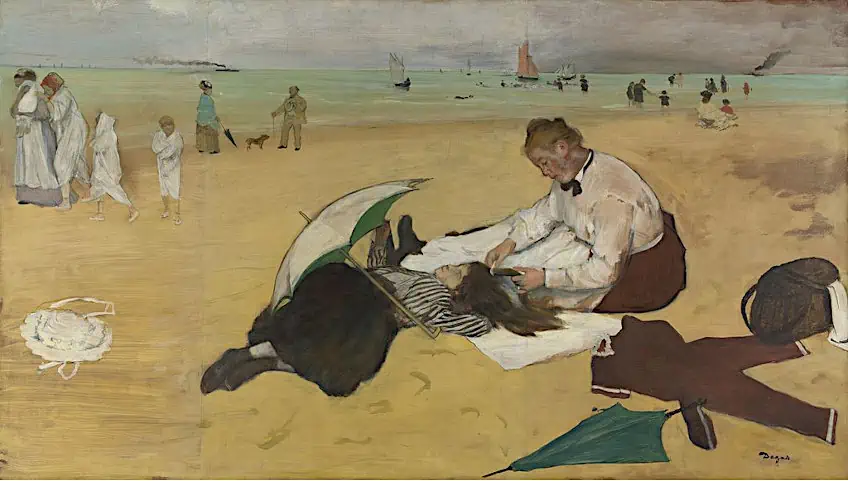 Beach Scene by Edgar Degas (from 1876 to 1877). A feeling of intimacy within a public environment is achieved by visually isolating the group comprising the woman and the girl; Edgar Degas, Public domain, via Wikimedia Commons
Beach Scene by Edgar Degas (from 1876 to 1877). A feeling of intimacy within a public environment is achieved by visually isolating the group comprising the woman and the girl; Edgar Degas, Public domain, via Wikimedia Commons
You could emphasize an element by making it either bigger or smaller than the other components in the design. A little object, for instance, will stand out against a vast background.
Unusual Elements
In art, the production of the unusual is an approach used to emphasize a composition by incorporating an unexpected element. This method may be used to confuse the audience, produce suspense, and bring attention to a certain element of the artwork. When an artist adds an unusual element to the artwork, they are disregarding the rules or traditions of their particular medium or style on purpose. They could, for instance, apply a bold and unusual color palette, or blend markedly different materials in surprising ways.
Unexpected elements can generate a sense of unease, surprise, or visual appeal, which can grab the viewer’s attention and accentuate a certain feature of the artwork or emphasize a core theme or idea.
 The Supper at Emmaus by Caravaggio (c. 1601). The little basket of fruit seems more at home in a traditional still life painting than this dramatic moment of divine revelation. Until the viewer notices that it hovers precariously over the edge of the table, thereby emphasizing the miraculous nature of the overall scene; Caravaggio, Public domain, via Wikimedia Commons
The Supper at Emmaus by Caravaggio (c. 1601). The little basket of fruit seems more at home in a traditional still life painting than this dramatic moment of divine revelation. Until the viewer notices that it hovers precariously over the edge of the table, thereby emphasizing the miraculous nature of the overall scene; Caravaggio, Public domain, via Wikimedia Commons
Convergence
Another popular approach for producing emphasis is convergence, which directs the viewer’s attention to a single spot or region within the composition. This can be implemented by employing lines, forms, or other visual features that direct the viewer’s attention to a certain focal point.
 Oath of the Horatii by Jacques-Louis David (1784). The convergence of visual elements such as the brothers’ arms, and placement of the central figure within the architecture combine to draw they eye to the hilts of the swords; See page for author, Public domain, via Wikimedia Commons
Oath of the Horatii by Jacques-Louis David (1784). The convergence of visual elements such as the brothers’ arms, and placement of the central figure within the architecture combine to draw they eye to the hilts of the swords; See page for author, Public domain, via Wikimedia Commons
Convergence is rooted in the notion that our eyes are naturally drawn to areas of strong contrast, as well as lines or shapes that point to a specific place in space.
Convergence could produce emphasis in a variety of ways. For instance, employing linear perspective to lead attention to the vanishing point; rotating the subject’s head will encourage us to look in that direction too.
Subordination
In art, subordination emphasis means de-emphasizing the whole image aside from the focal point. Any visual elements of art may be used to produce subordination, with the most popular being value, color, texture, and space. As already mentioned, isolated color, as well as missing color, are excellent examples of utilizing value and color as tools for subordination. In addition, just add lighter values and saturation to the focal point in comparison to the remainder of the artwork.
Detailing is frequently used in artworks to add emphasis. The objective is to give the primary topic more details or a greater quality of rendering than the remainder of the artwork.
 Orpheus and Eurydice by Auguste Rodin (1893). Rodin reserves the greatest degree of detail for the hand with which Orpheus covers his eyes, since the moment he turns to look at his wife, he will lose her to Hades again; Auguste Rodin, CC0, via Wikimedia Commons
Orpheus and Eurydice by Auguste Rodin (1893). Rodin reserves the greatest degree of detail for the hand with which Orpheus covers his eyes, since the moment he turns to look at his wife, he will lose her to Hades again; Auguste Rodin, CC0, via Wikimedia Commons
Location
The placement of an object in the artwork could be used to achieve emphasis in a variety of ways. An artist might direct the audience’s eye to an object by arranging it in a certain spot within the work, creating a sense of significance. For instance, positioning an object in the composition’s middle or at a point of junction in the Rule of Thirds grid might help it stand out.
The placement of an object may also add context and significance to an artwork. A small individual in the foreground of a landscape painting, for instance, may create an impression of scale and emphasize the immensity of the environment.
 Mr. and Mrs. Andrews by Thomas Gainsborough (between 1748 and 1750). By placing the sitters not in the center, as would be the convention, but to one side of the image, Gainsborough places equal compositional emphasis on the couple and the source of their wealth; Thomas Gainsborough, Public domain, via Wikimedia Commons
Mr. and Mrs. Andrews by Thomas Gainsborough (between 1748 and 1750). By placing the sitters not in the center, as would be the convention, but to one side of the image, Gainsborough places equal compositional emphasis on the couple and the source of their wealth; Thomas Gainsborough, Public domain, via Wikimedia Commons
The Seven Principles of Art Overview
- Principles of Art Overview
- Balance in Art
- Movement in Art
- Contrast in Art
- Pattern in Art
- Unity and Variety in Art
- Proportion and Scale in Art
As we have learned, the application of visual elements and arrangement to create a focal point or region of significance within a piece of art is referred to as emphasis in art and is one of the principles of art. Artists frequently utilize emphasis to focus the viewer’s attention on a certain portion of the artwork or to express a specific message or idea. For example, adding contrasting colors, values, or forms can produce a visual “pop” to the artwork that captures the attention of the observer.
Frequently Asked Questions
What Is Meant by Visual Emphasis?
By adding visual emphasis, artworks become more interesting and engaging to the observer. There are many examples of emphasis in art that use methods such as contrast, isolation, location, and various unusual elements to emphasize the aspects of the work that they most want audiences to focus on. It is one of the principles of art that are used by artists to add interest and value to their works.
Where Do I Add Emphasis in Art?
You can add it to any element that serves as a focal point of your artwork. It can also be added to a specific part of the work where you want people to look first, and then you can apply other techniques to move their focus around the canvas in the direction you prefer. By locating your focal point in the middle of the canvas, the optimum amount of emphasis can be achieved.
In 2005, Charlene completed her wellness degrees in therapeutic aromatherapy and reflexology at the International School of Reflexology and Meridian Therapy. She worked for a company offering corporate wellness programs for several years before opening her own therapy practice. In 2015, she was asked by a digital marketer friend to join her company as a content creator, and it was here that she discovered her enthusiasm for writing. Since entering the world of content creation, she has gained a lot of experience over the years writing about various topics such as beauty, health, wellness, travel, crafting, and much more. Due to various circumstances, she had to give up her therapy practice and now works as a freelance writer. Since she is a very creative person and as a balance to writing likes to be active in various areas of art and crafts, the activity at acrylgiessen.com is perfect for her to contribute their knowledge and experience in various creative topics.
Learn more about Charlene Lewis and about us.
